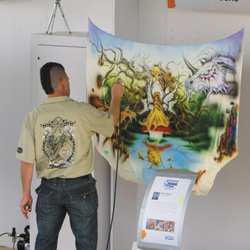|
REGISTRATION REQUIRED
case study

BRAIN TEASERS
GE Healthcare deploys an interactive game at the Radiological Society of North America annual meeting to demonstrate the time-saving benefits of its newest MRI machine, drawing more than 1,100 contestants. By Lena Hewitt
How do you demonstrate a multi-million-dollar piece of medical equipment – that can take up to two hours to complete its task and weighs more than 10 tons – on the trade show floor? The short answer is that you don't. The logistical road blocks of getting an MRI machine to a convention center, powering it up, running it for several days, and then shipping it back home far outweigh the benefits of having a working piece of equipment on site. And if you've seen one MRI machine operate, you've seen them all. So even if it was deemed worthwhile to have a functioning machine at a health-care show, the chances of it drawing a crowd are slimmer than a blood smear on a pathology tissue slide. That's why GE Healthcare, a division of General Electric Co., left its new Signa Pioneer 3.0 Tesla MRI machine at home during the Radiological Society of North America (RSNA) annual meeting and instead developed an engaging in-booth activity to convey the product's selling points.
Considering that one scan using a conventional machine can take more than an hour, the Signa Pioneer has the potential to disrupt the medical community. In short, the machine allows technicians to scan more than one patient per hour per day. That's a boon for hospitals and clinics, many of which rely on a handful of machines to serve their entire patient population. Furthermore, an MRI machine needs to capture six "image contrasts," or views, of each subject it's scanning. Traditional machines scan the same subject six times, with the technician changing the settings between scans to capture all six views as separate files. The Signa Pioneer, on the other hand, is a "one and done" process in which six image contrasts are collected from a single scan. Plus, the Signa Pioneer allows doctors the ability to adjust those contrasts after the scan is complete; whereas, previous MRI machines required doctors to redo the entire process if the original settings did not result in an optimal image. The shorter scans also benefit patients, many of whom experience anxiety due to the limited space inside the MRI tube, not to mention the need to periodically hold their breath and lay still. It's a win for doctors, patients, and hospital administrators. But the question remains: How do you demo the benefits of a machine that isn't even in your exhibit? Video Player is loading. Verbally explaining the technology would work just fine, as would graphics denoting the product's benefits. But the RSNA audience is a hands-on, show-don't-tell kind of populace. Additionally, doctors are inherently competitive. To wit, Dr. Stefan Larsson, who gave a TED Talk on how a sharing culture in the medical field could improve health care, said, "Physicians are very competitive. If someone can show them that the results they get for their patient are no better than what others get, they'll do whatever it takes to improve." Sounds like a target market tailor-made for a little friendly competition. So rather than rely on sales pitches and banner stands, GE Healthcare partnered with Stamm Media, a Milwaukee-based tech company, to develop a competitive, interactive demo. The Magic Eye game, so named for Signa Pioneer's "magnetic resonance image compilation," would pit two to four attendees at a time against one another in a 60-second battle. The task: Score points by manipulating brain scans on the right to accurately resemble control images on the left. The player with the most points after one minute would be declared the winner, with his or her name added to a leader board for all of RSNA to see. And as any health-care marketer will tell you, there's no better way to attract doctors to your booth than the lure of bragging rights. 
When the doors to RSNA opened, sterile medical equipment dotted the horizon. Device demonstrations and educational presentations were more pervasive than the sniffles at a preschool. The GE Healthcare exhibit, however, contained a peculiar sight – a mostly snow white, tensioned-fabric tunnel in the middle of the company's space. A tall rectangular structure in a cobalt blue hue featured the provocative question "Do you have the Magic Eye?" And an LED monitor mounted to the structure showcased the soon-to-be-filled leader board. After booth staffers greeted visitors, they invited interested attendees to enter the Magic Eye tunnel to put their MRI-matching skills to the test. Up to four players at a time took their respective places in front of touchscreen monitors located inside the tunnel. They entered their contact information and viewed a three-minute video about the Signa Pioneer and how to play the Magic Eye game. The video also featured a booming voice-over: "Welcome to a game of clinical accuracy and speed â?¦ competing against some of the sharpest imaging experts in the world." And that's all the invitation contestants needed to get started. 
When 60 seconds had elapsed, the player with the most points was named the winner, as the voice-over bellowed, "You have the Magic Eye!" All scores went up on the leader board, with high scores pushing out lower earners. From start to finish, the experience lasted roughly four minutes, allowing GE Healthcare to pack in as many players as possible throughout the show. "The game drew an impressive crowd," says Greg Ventzke, account executive at Stamm Media. And that could have proved a double-edged sword if potential contestants tired of waiting in line and departed, destined for competitors' booths. Thankfully, Ventzke and his team had proactively prepared for that. "We anticipated the game's popularity and incorporated two monitors mounted on the outside of the arch, whose content kept those in line engaged, rotating between the leader board and informational videos about the new product." 
By the time the last head-to-head battle was waged, more than 1,100 contestants had tried their hand at matching MRI scans, equaling 73 hours of time spent in GE Healthcare's booth and far surpassing the company's expectations. More importantly, all of those visitors viewed a three-minute video that educated them about the new Signa Pioneer. By capitalizing on the audience's love of a little friendly competition, GE Healthcare's Magic Eye game attracted attendees and brought product selling points to life via a fully immersive experience – all for a fraction of the cost of hauling an MRI machine to the show floor. And as it turns out, that's just what the doctor ordered. E 
|
|
|
||||||||||||||||||||||||||||
|
|
||||||||||||||||||||||||||||
|
TOPICS Measurement & Budgeting Planning & Execution Marketing & Promotion Events & Venues Personal & Career Exhibits & Experiences International Exhibiting Resources for Rookies Research & Resources |
MAGAZINE Subscribe Today! Renew Subscription Update Address Digital Downloads Newsletters Advertise |
FIND IT Exhibit Producers Products & Services All Companies Get Listed |
EXHIBITORLIVE Sessions Exhibit Hall Exhibit at the Show Registration |
ETRAK Sessions Certification F.A.Q. Registration |
EDUCATION WEEK Overview Sessions Hotel Registration |
CERTIFICATION The Program Steps to Certification Faculty and Staff Enroll in CTSM Submit Quiz Answers My CTSM |
AWARDS Exhibit Design Awards Portable/Modular Awards Corporate Event Awards Centers of Excellence |
NEWS Associations/Press Awards Company News International New Products People Shows & Events Venues & Destinations EXHIBITOR News |
||||||||||||||||||||
|
||||||||||||||||||||||||||||






